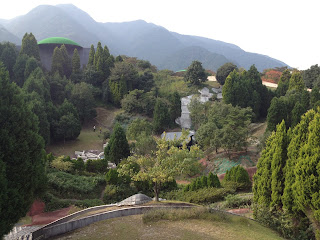 |
| Handpainted train warnings - a true sign of a good rural station. |
Choo-choo. I love tiny train lines in rural Japan, rattling and chucketing through grass fields. I also love Gifu, so what better way to spend a Friday than taking a train through Gifu? This week I got to experience something I'd wanted to see for a while - the Site of Reversible Destiny in the small town of Yoro. Best described as a surrealist park-slash-art-exhibition, the Site of Reversible Destiny promises an Alice in Wonderland-type experience, which toys with your perceptions and aims to leave you disoriented. Did it succeed? We shall see.

We set off from Nagoya station, with the aim of taking the JR line to Ogaki (30 minutes), then changing to the Yoro line, which trundles alongside the Yoro mountain rage through Gifu and down to Mie at a maximum speed of a whopping 40 miles per hour; however we got a little delayed when we decided to stop at Ogaki station for some lunch. I actually used to work in Ogaki, so I felt like I was going to be the big authority on all things Ogaki-related, but when I got there I was shocked to find that everything had changed. There's a Pizza Hut now. Once you leave a place you can never really go back again. (We didn't go to Pizza Hut by the way, we got misokatsu instead. Not because we're all culturally superior and only eat Japanese food, Pizza Hut is just really expensive here.)
Timing ourselves terribly, we got onto the train platform and then had to wait for half an hour for the tiny adorable train to come. It was worth it though. I love trains.

At Yoro station we were greeted by the national animal of Mie which is giant spiders everywhere making webs that are bigger than your house. Staying safely away from all nooks, we strolled down the middle of peaceful roads. Even if we weren't going to a surrealist art park, the trip would have been lovely. These small towns have a lot going for them - calm winding roads, lovely scenery in the distance, and of course the local thing. Every town in Japan has a local thing, if the population is three old men and a dog. In Yoro, it appears the local thing is gourds. I didn't know why, but a quick Google suggests there's a local story about a boy who used a gourd to fetch magical sake from a spring, to comfort his sick father. See, even the uncomfortable familial dynamics of alcoholism is charming in Yoro.

Onto the Site of Reversible Destiny: at the ticket counter we were asked where we were from, and then given quite a nice pair of chopsticks each. I swear to you, the actual phrase used by the smiley woman at the counter was "gaijin present desu". Entering the park we found a series of mind-bending buildings and recreational areas with passages that lead into oddball corners, furniture sticking out of walls and angles designed to play with perceptions. As well as the chopsticks, we got an advisory pamphlet in English, which might actually be one of my favourite pieces of writing I've seen in a while. Though at first it could be mistaken for vague, poorly-translated English, after a few sentences of reading you realise the abstract style is very deliberate and precise, slightly wry in its absurdities, and really quite enjoyable. A few highlights:
"If thrown off balance when entering the house, call out your name or, if you prefer, someone else's."
"Strive to find a marked resemblance between yourself and the house. If by chance you fail to do so, proceed even so as though the house were your identical twin."
"Should an unexpected even occur, freeze in place for as long as you see fit. Then adopt a more suitable (for being more thought out) position for an additional twenty seconds or so."
"Always question where you are in relation to visible and invisible chains of islands known as Japan."
"Move in slow measured steps through the Cleaving Hall and, with each arm at a distinctly different height, hold both arms out in front of you as sleepwalkers purportedly do."
"It may take several days to find everywhere in the house that the dining room is."
"Inside the Geographical Ghost, renege on all geographically related pledges of allegiance."
"Within the Zone of the Clearest Confusion, always try to be more body and less person."
***
This park/exhibition (parxibition?) was definitely nothing like anything I'd seen before, and the surroundings were gorgeous too .There were a few people around but the park opened quite a few years ago now and you could tell it wasn't a big attraction any more, if it ever was, and was looking a bit run-down. Mostly this added to its charm, but it did have its downsides - for all the playful geometrics, the biggest surprise I actually got was a dead bat in one of the corridors. I don't think it was meant to be there. I also bumped my head on a tunnel roof twice in five minutes, which was a bit painful.
Still, I had a great day out. I really want to make more use of my time and take more day trips like this, not necessarily to big tourist destinations but to nice everyday places with their own quirks. Hopefully fewer spiders though. And dead bats. And tunnels.

















